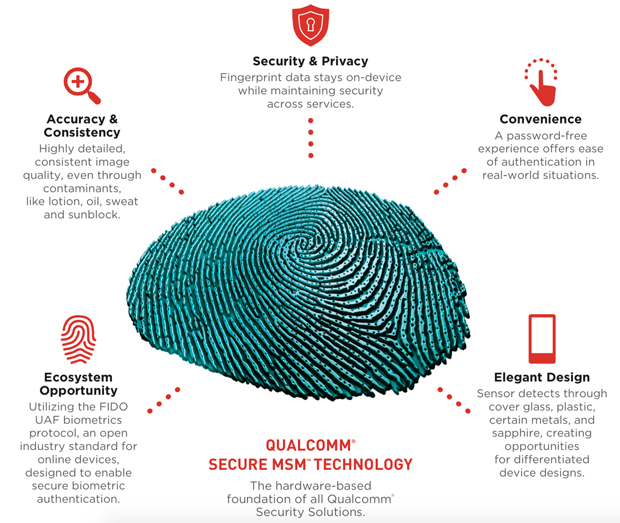Qualcomm’s Sense ID Fingerprint Reader Can See Through Plastic And Metal, Tackle Grimy Fingers
When it comes to fingerprint technology used in today’s smartphones, many look to Apple’s Touch ID as the standard-bearer. Touch ID was introduced with the iPhone 5s and was improved upon with the iPhone 6, iPhone 6 Plus, and iPad Air 2. Touch ID provides 360-degree readability, doesn’t require you to swipe your finger (as its name implies), and provides authentication for Apple Pay.
But Qualcomm has announced a new fingerprint reader, Snapdragon Sense ID, which looks to one-up Apple through the use of ultrasonic sound wave technology. Qualcomm claims that the ultrasonic technology used in Sense ID is more accurate than the capacitive touch sensor used with Touch ID, and promises to deliver accurate and consistent reads even if your finger is dirty, wet, or lathered in lotion/sunblock.
Even more interesting is the fact that the sensor can be built discretely into the design of a smartphone, tablet, or laptop without the need to have a separate button or selection of materials to hide behind. So in theory, the sensor could be built integrated into glass “surround” of your smartphone or tablet, or mounted within the plastic/aluminum housing of a device with no visible seams to draw your attention.
And whereas Touch ID uses a 2D image of your fingerprint, Sense ID captures a 3D image that is able to discern “unique and subtle features of a user’s fingerprint by penetrating the outer layers of the skin. In addition, “sound waves fill the intricate nooks and crannies of the skin, resulting in an incredibly detailed map of the ridge endings, bifurcations, and even sweat pores that make each individual fingerprint so unique.”
Qualcomm feels that this 3D mapping makes Sense ID more secure than competing solutions, and also harder to spoof as we’ve seen with Touch ID. Qualcomm has also taken additional measures to ensure that fingerprint data is stored only on the device — like Touch ID — and is not uploaded to the cloud, so security concerns should be alleviated.
Snapdragon Sense ID will first be made available on devices running Snapdragon 810 and Snapdragon 425 processors, but is also comparable with all Snapdragon 400, 600, and 800 series processors.


